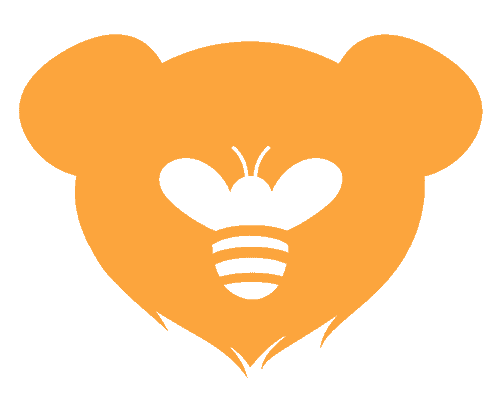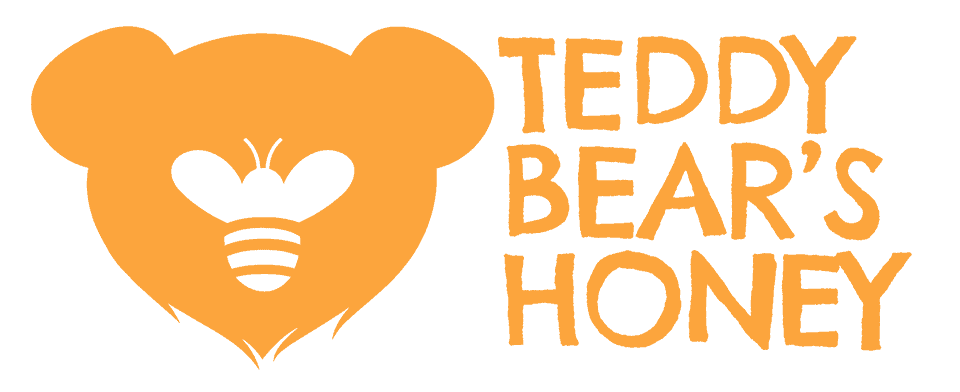Bumblebees are the gentle, fuzzy-buzzy, black-and-yellow giants of the bee world. Like Honeybees, they live in social colonies with a single queen, female worker-bees, and male drone-bees. Unlike Honeybees, they do not make honey. They are excellent pollinators that collect nectar and pollen. They do not store this as honey because of their short lifecycle, ending before winter.
Bumblebees collect nectar and pollen that they store in minuscule amounts in tiny wax pots as food for the queen and her offspring. This is unlike honey, which contains less moisture and Honeybee enzymes. Bumblebees do not live through winter like Honeybees that need extra honey sustenance.
In Old English, Bumblebees were called Hummel-bees or Dumbledores (just like the wizard headmaster in the Harry Potter novels.) These intriguing, attractive insects are a great bonus to any garden, even though they do not make honey. The pollen food they make is stored in nectar pots. Bumblebees have good reasons for not turning pollen and flower nectar into honey.
Do Bumblebees Produce Honey?
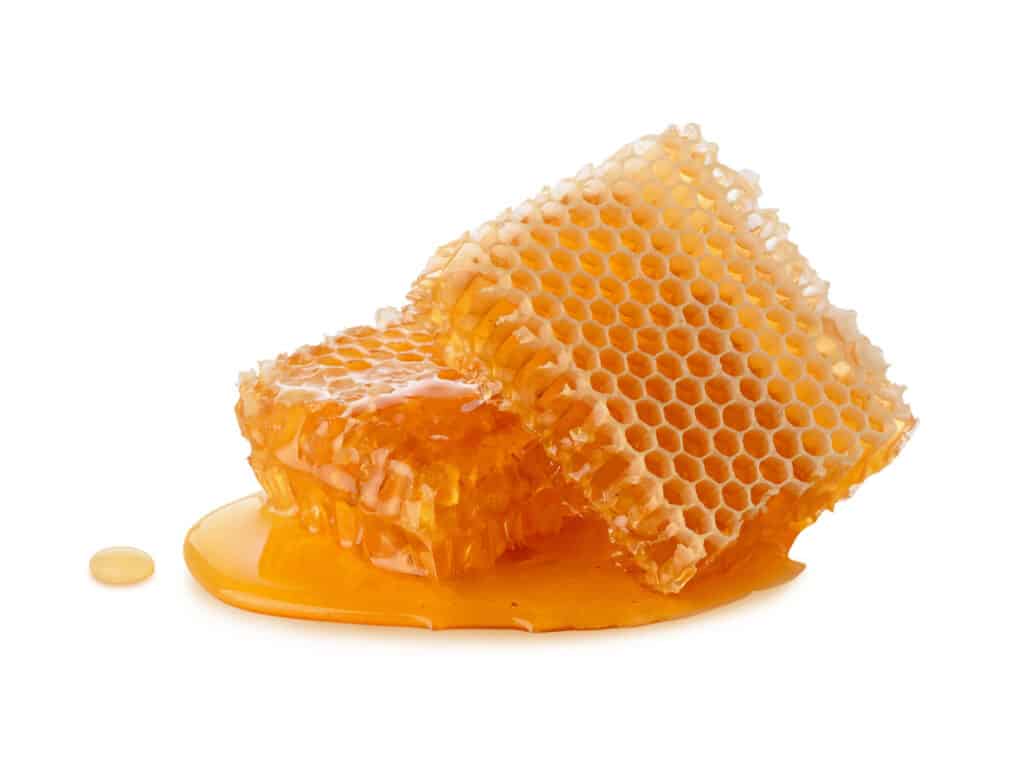
Bumblebees are very active pollinators and collectors of pollen, but they do not make honey. They have a short, annual lifecycle, and it is only the Bumble-queen that lives through winter. Bumblebees are active from February just before spring until late autumn in November. After this, the colony dies, leaving only the potential new queen hibernating in the underground nest.
Honeybees turn pollen and nectar into honey to have a preserved food source through winter when flowers are scarce. Bumblebees do not need winter food. They have bigger bodies than Honeybees and have to forage various flower species to meet their daily energy needs. Bumblebees need 150 milligrams of sugary nectar daily. Pollen adds protein to their diet and is mainly fed to the larvae.
Female Bumblebees (like Honeybees) have a pollen basket (Corbicula) on their hairy hind legs for storing pollen that they take back to the nest. The Bumblebee queen excretes wax from an abdominal gland and makes tiny wax pots. Once she has eaten enough, the nectar & pollen mix is stored in the wax pots. This is the food for the next generation, and the queen deposits her eggs inside the wax pots before sealing them.
Bumblebee colonies with 50 to 500 individuals are much smaller than Honeybee colonies with up to 80 000 bees. Even though the nectar inside the Bumblebee pots can be considered edible, it would be foolish to collect a few drops of nectar that the Bumblebees need to survive. Collecting the nectar pots would also jeopardize a colony of Bumblebees already endangered.
The Difference Between Honey, Bee-Bread, And Bumblebee’ Honey’
The wax-pots Bumblebees store their larval food in are sometimes called honey pots. These are inside the Bumblebee nest, usually in an underground cavity, deserted mouse holes, or sometimes in hollow trees and bird nests. To understand how the content of these Bumblebee pots is different from honey, we need to understand what honey and bee bread are.
How Do Bees Make Honey?
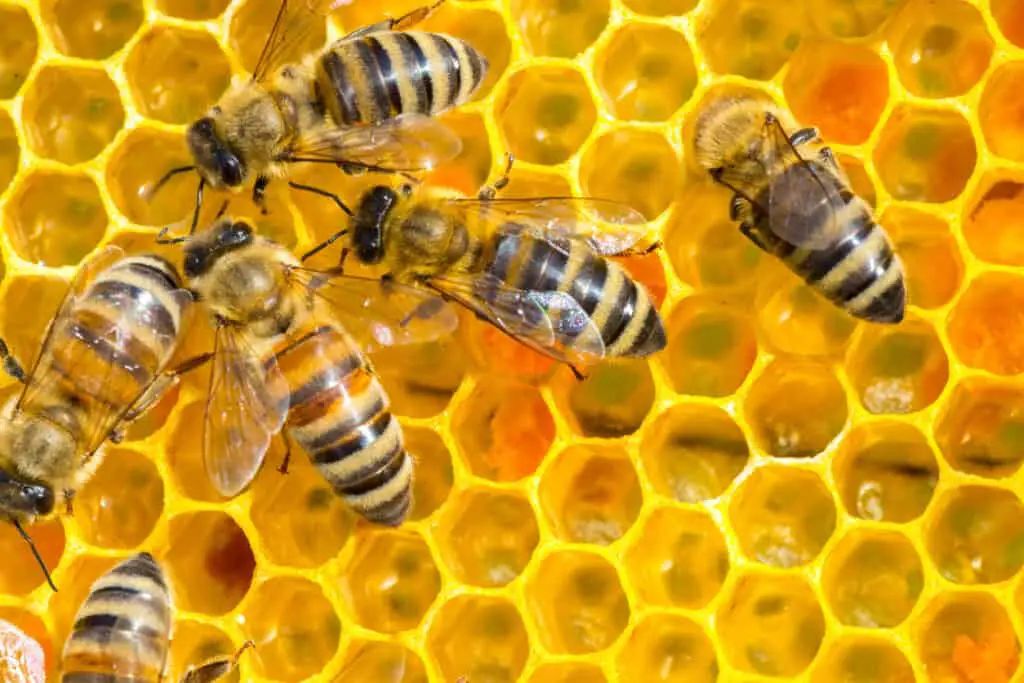
Honeybees make honey, but how do they turn liquid nectar into a thick golden substance with an unlimited shelf life? Honey can be defined as a sugar-rich, partially fermented food source activated by enzymes and made by bees from nectar collected from flowers. Invertase is the enzyme that changes sucrose into fructose and glucose, which are easier to digest for bees and humans.
Most bee species have long tongues to extract the sweet nectar from flowers. Honeybees store the nectar in a crop or special nectar stomach. Here, it mixes with enzymes that change the pH and improve the sweet liquid’s storage potential.
Honeybees return to the hive after collecting nectar, and this liquid is regurgitated backward and forwards between different bees. The nectar, which has now been partially digested, is then poured into the wax cells of the honeycomb. This liquid still has too much water in it to be considered honey.
The bees work together, fanning the nectar with their wings to aid the evaporation of the water content. Nectar contains about 70 % water, compared to the 18,6% water content in liquid honey. Less water protects honey from microbes that could cause fungal and bacterial contamination.
The Honeybees seal the pockets of honey with wax, which preserves it away from air, water, and other pollutants. This is the winter food that Honeybees keep in reserve. Honey’s taste, color, and consistency depend on the types of flowers the bees harvest nectar from. Because Honeybee colonies are so big, it is possible to gather some of the honey without damaging their chances of survival.
What Is Bee-Bread?
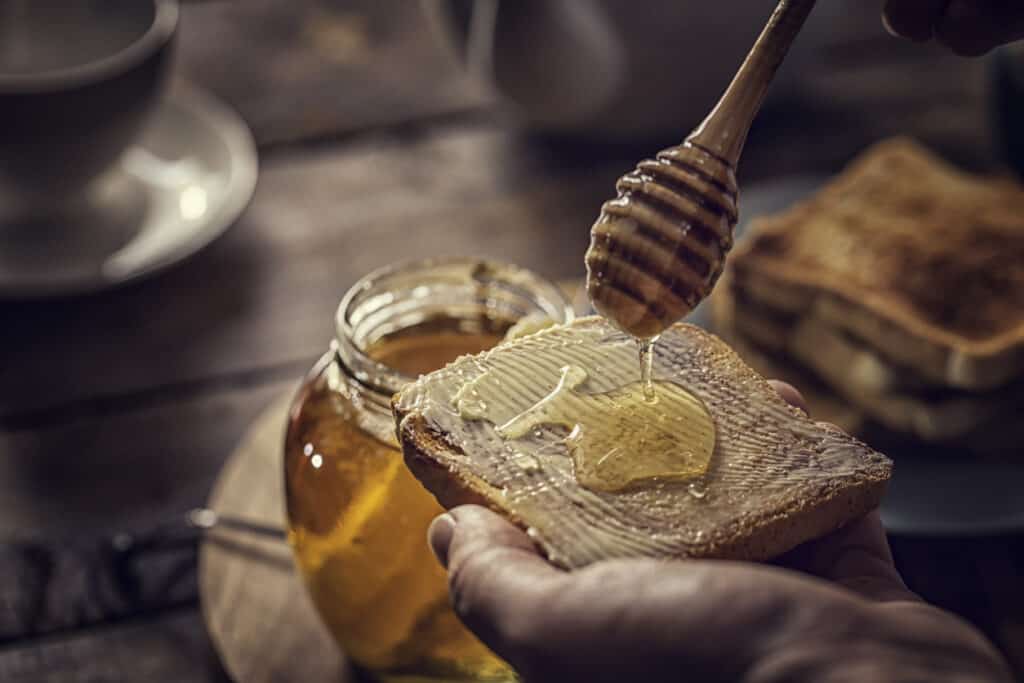
All bees carry pollen between flowers and pollinate plants, which is essential for forming viable seeds and fruit. Bees also use pollen as a source of protein. Raw pollen is covered with a cellulose layer that bees cannot digest. Bees make a fermented, enzyme-activated food by combining 70% pollen and 25% nectar with their saliva. Bee saliva contains enzymes, yeasts, and probiotic bacteria.
Pollen with a short lifespan is now bee bread with a long lifespan. This is an easily digestible source of protein. Minerals like magnesium, zinc, silica, selenium, vitamin K, and B complex vitamins are found in bee bread. It is also called Perga or Ambrosia when marketed as a potent health supplement for humans.
What Is Inside Bumblebee Honey-Pots?
The Bumblebee queen regurgitates nectar and pollen into the beeswax pots that serve as emergency food for 2 or 3 days. She drinks from the pots while making extra pots filled with pollen. In each of these, she lays 4 – 16 eggs and then covers this brood clump with a layer of wax. Eggs hatch in roughly four days, and larvae feed on pollen that the solitary mom/ queen collects. Larvae mature within five weeks.
Bumblebee honey pots are a food source and give information about where quality nectar can be found. Bumblebees in the nest will probe and sample honey pots. When the prober-bee finds nectar of good quality and quantity, it will do a high-energy dance. The bee spreads a pheromone signal that alerts other bees to fly into action. They only do this if the stores of nectar need replenishing.
Bumblebees also make bee bread from pollen, enabling better digestion and nutrition of this protein source. Bumblebee bread is not of the same quality and quantity as Honeybee bread.
The Life Cycle Of A Bumblebee Colony
Bumblebees do not produce honey. This is fundamentally linked to the short Bumblebee lifecycle as these colonies do not live through winter. The climatic conditions and available food sources in the area influence when the solitary queen will start the new settlement of Bumblebees. Here is the sequence of events in early spring, after the queen hibernated alone in the nest.
- New queens that hatched at the end of the Bumblebee colony’s previous life cycle start waking up and looking for food. This is a critical time as flowers are still scarce.
- The Bumble-queen finds a nesting site in a cavity close to flowering plants.
- She makes a tiny wax pot and fills it with a small food reserve of nectar and honey.
- Eggs fertilized by sperm retained from the previous season are laid in pollen balls and covered with wax. The queen looks after the brood and flies out to find food every day.
- The larvae hatch and grow through four or five instars in a month. They eat the pollen the queen collects.
- The larvae turn into female adult workers who feed on nectar. They start collecting food for the next batch of larvae, and the queen now focuses on laying eggs.
- When summer ends, the queen starts laying eggs that will become new queens. She omits a specific pheromone when she lays these eggs and feeds the larvae more food.
- The queen lays unfertilized eggs that will hatch into male Bumblebees called drones.
- The adult males cause chaos in the nest by raiding the honey pots; this is the beginning of the last cycle in the colony’s life.
- The male bees fly out and lure the emerging queens with their pheromone trails.
- After the male bees mate with the queens, they die.
- The new queens have to find lots of food fast to build up the energy needed to survive the winter. They find a protected cavity underground where they will stay till the following spring.
- The queen slows her metabolism and is protected from freezing by having Glycol in her blood.
- Meanwhile, food becomes scarce, and the old queen and bees of the original colony start dying.
The Similarities & Differences Between Bumblebees & Honey Bees
Bumblebees and Honeybees belong to the family Apidae. They are both eusocial bees forming colonies and sharing a nest with a single queen. Bumblebee colonies are much smaller and shorter-lived than Honeybee colonies. Both species collect nectar and pollen and have the same ecological function. A big difference is that Bumblebees do not produce honey.
There are 250 different types of Bumblebees in the genus Bombus. The most common Bumblebee in America is the Eastern Bumblebee (Bombus impatiens). There are eight recognized species of honey bees, of which the Western Honeybee (Apis mellifera) is the most well-known. Bumble and Honeybees are highly adaptable species that can flourish in the wilderness or cities.
Below is a comparison of the habits and characteristics of these two types of bees.
| Bumblebees | Honey bees | |
| Honey making | Do not make honey. Bumblebees use honey pots for small amounts of nectar and pollen | Make honey kept inside a honeycomb in the hive |
| Appearance | Robust, hairy, rounded body 0,6 to 1 inch long, black with yellow or orange bands and dark wings | A slender, oval-shaped body that’s 0,02 inches long. Golden with darker brown bands and translucent wings |
| Nesting sites | Cavity nesting mostly underground, sometimes in hollow logs and bird nests | Above ground in sheltered spots |
| Inside the nest | Clusters of oval nectar pots, somewhat randomly organized | Hexagonal honeycombs, very orderly |
| Colony size | 50 – 500 bees | 20 000 – 80 000 bees |
| Organization of labor | Less organized with only female worker bees | Highly organized divisions of labor for maximum efficiency in a giant hive |
| Mating behavior | The queen leaves her nest and mates with outsider males, but only with one of them | The queen leaves her nest and mates with up to 40 outsider males |
| Communication | Communicating through body language and pheromones | Highly developed communication through body language, pheromones, and nectar transfer between bees |
| Aggressiveness | Not aggressive but will defend their nest. Bumblebees can sting more than once and do not die after stinging. Only females have stings | Not aggressive but will defend their nest. Males and females have stings. They can sting only once and die after stinging |
| Flying ability | Strong fliers that fly up to 6,2 miles from the nest. Can fly against strong winds | Strong fliers that fly up to 5 miles from the nest. Not able to fly against strong winds |
| Pollination techniques | They are more efficient pollinators than Honeybees. Pollen is stored in corbiculae on the hind legs. Buzz pollination is achieved through vibrating the wing muscles, and big hairy bodies trap large quantities of pollen | Pollen is carried in pollen baskets (corbiculae) on the hind legs. Pollinate by brushing against pollen sticks to the bee’s body and hair. |
| Longevity | The Bumblebee queen survives for a year and lives through winter. Other bees and the whole colony survive less than a year | The Honeybee queen and her brood often live in the same nest for more than a year and overwinter in the hive. The queen lives three or more years |
| Tongue length | Different species have varying tongue lengths of up to 0,64 inches. Long tongues can reach into tubular flowers | Honeybee tongue lengths are up to 0,24 inches. Cannot access the nectar in some flowers |
| Weather adaptations | Big hairy bodies are adapted for generating more heat. Resistant to cold, wet, and windy conditions. They do not hibernate | They hibernate in winter, staying warm by massing together. Less active in cold weather. Not resistant to wet, windy conditions |
Bumblebees Are Buzz-Pollinators
Bumblebees are highly effective pollinators. The five main reasons that they are considered better at the job than Honey bees and some other pollinating insects are:
- Bumblebees have big bodies that can carry large quantities of pollen.
- They are incredibly hairy, and each hair has a microscopic fork at the tip. Every bee hair is a pollen gathering and transporting tool.
- There are short and long-tongued Bumblebees. Long tongues can reach pollen in flowers with complex and tubular structures like honeysuckle and delphinium flowers. They can pollinate a wider variety of flowers than Honey bees.
- They are robust and can keep collecting pollen in cold and windy weather.
- Bumblebees actively collect pollen earlier in the season and earlier in the morning than most other bees.
- They are buzz-pollinators, using vibrations to dislodge pollen.
What Is Buzz-Pollination
Some flowers do not release their pollen to just any passing bee. Six percent of flowering Angiosperm plants have anthers (pollen-producing part of the stamen) where pollen can only escape through tiny slits and pores. Bumblebees have evolved to pollinate these types of flowers. This is a mutually beneficial arrangement meaning more effective pollination for the flower.
Bumblebees have less competition when harvesting this abundant source of high-protein pollen. They grab hold of the anther while touching other parts of the flower with their legs. They then start vibrating their wing muscles. The wings’ audible buzz is made by beating over 130 times per second. The pollen is loosened via sound frequencies and physical vibrations and explodes onto the bee’s body.
The Bumblebee combs the pollen into the pollen pouches on their hind legs. Some pollen will still stick to their hairy bodies, pollinating the next flower they visit. Commercial plants that require buzz-pollination are tomatoes, blueberries, eggplants, and kiwis.
Bumblebees As Commercial Pollinators
Some agricultural plants bear better quality fruit if they are buzz-pollinated. Bumblebees are in great demand at enterprises that grow berries, tomatoes, peppers, and opium poppies on a large scale. Colonies of Bumblebees are imported for pollination work in greenhouses as a less cumbersome alternative to doing it manually. These imported Bumblebees are part of a billion-dollar industry.
Five different species of Bumblebees are used to pollinate roughly 20 types of commercial food plants. Bumblebees (Bombus species) sales for commercial pollination are between 60 and 70 million dollars each year. The buzz-pollinated crops are valued at more than 13 billion dollars annually.
There are, unfortunately, severe consequences when bee species are introduced at this scale where they do not belong. Bumblebee queens are treated with carbon dioxide to lengthen the lifecycle of Bumblebee colonies and have adult bees available year-round. In-depth studies need to be done to determine the long-term effect of this treatment on bee health.
Local species of wild Bumblebees and Honeybees are often infected with pathogen spillover resulting from contact with introduced commercial Bumblebees. The Bumblebees reared and imported for commercial gain often possess more disease pathogens and parasites than wild bees. The infected bees escape greenhouses and forage outside, where local wild bee populations become infected.
This is a severe problem as bee diversity worldwide is already in crisis.
Why Are Bumblebees Important?
Bumblebee diversity is critically important for the survival of healthy ecosystems. They are essential pollinators of many wild and commercial plant species that feed a whole network of other animals, insects, birds, and people.
Although they are not makers of honey, Bumblebees indirectly help the Honeybees to produce honey by ensuring the survival of wildflower species.
Bumblebees are precious, beneficial, and unique creatures that are fun to watch as they buzz about covered in pollen. Brian L. Griffin is the author of various books about the Bumblebee. He calls a Bumblebee the “gentle giant of the blossoms, that somehow awkward, slow, bumbling bear of a bee.”
Are Bumblebees Endangered?
Bumblebee diversity is declining, just like many other insect species on our planet. Various Bumblebees are under threat, endangered, and face extinction. According to the Xerces Society and IUCN Bumblebee Specialist Group, more than 28% of Bumblebees in North America face the risk of extinction. That is a quarter of American Bumblebees. The Rusty-patch-Bumblebee (Bombus affinis) was last seen in 1993.
The Xerces Society mentions the following species of Bumblebees as endangered:
· Rusty Patched Bumble Bee
· American Bumble Bee
· Crotch’s Bumble Bee
· Franklin’s Bumble Bee
· Morrison Bumble Bee
· Obscure Bumble Bee
· Southern Plains Bumble Bee
· Variable Cuckoo Bumble Bee
· Western Bumble Bee
· Yellow Banded Bumble Bee
· Yellow Bumble Bee
What Are Causing The Decline In Bumblebees Worldwide
Global warming impacts many bee species. Studies indicate that Bumblebees are severely affected by hotter conditions in Europe and America. The severe decline in Bumblebee populations (estimated at a 30% decline) has primarily happened in one human generation. Other factors that endanger Bumblebee survival are:
- Habitat loss and agricultural monocropping. Grasslands are essential Bumblebee habitats disappearing due to development and agricultural expansion
- Pesticide usage
- Disease and pathogens introduced by importing commercial-pollinator bee species
How To Protect And Attract Bumblebees
Everybody with a garden or a few potted plants on a balcony or patio can help Bumblebees survive.
Create a Bumblebee habitat by allowing an area of your garden to stay wild. Leave dead tree stumps in place and let leaf litter remain on the ground.
Bumblebees need a variety of flowers from which to collect pollen and nectar – to attract these precious creatures to your garden, plant diversity of indigenous flowers. Also, take care to plant early and late blooming species.
In spring, good food for Bumblebees is Primrose, Sweet rocket, Garlic mustard, and Aubretia. Plant Buddleia, Lavender, Honeysuckle, and Red Valerian as Summer food. Autumn flowering species that attract Bumblebees are Ivy, Ice plant, Hyssop, and daisies. Visit the Wildlife Trust website for a list of plants that Bumblebees love.
Bumblebees are gentle creatures that will not attack without having a solid reason to do so. If you have a Bumblebee nest in your garden, let it stay there in peace. Removing Bumblebee nests is not advised as the chances of the colony surviving this ordeal are very slim. Bear in mind that a Bumblebee colony has a short life, and within a few months, they will not be there anymore.
Conclusion
Bumblebees are not honey makers, but they are critically important in pollinating the flowers that all other bee species need for their survival. We need Bumblebees more than we need to eat honey.
